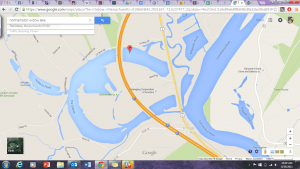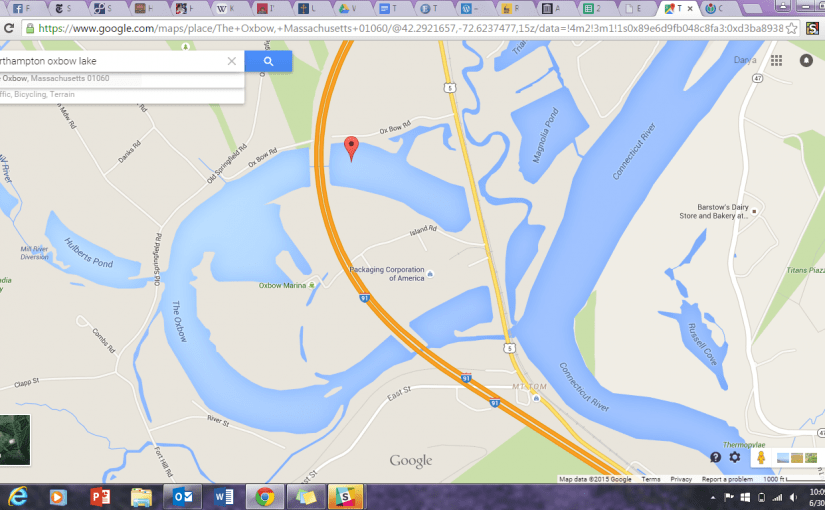(I’ve been thinking a lot about Harry Potter recently – had to make a bad syntactical reference)
THE PROMPT: Reflection. How has the visit to the Beneski shaped your understanding of Hitchcock and your research questions? Do you feel ready to begin making the transition from the learning phase of the internship to the project phase?
1) Beneski visit
This visit was one of the most concrete moments of conceptual progression so far – we left with more questions, more answers, and a better feeling of what we will explore. I took notes during the expedition, both of the tour that Kate Wellspring, Collections Curator of the Beneski Museum, and of our ponderings. Some highlights include:
- Hitchcock was originally interested in astronomy, but after a case of mumps, could not pursue that path because of his weak eyesight.
- The Most Coolest Thing: the idea of geological time
- I need to explain this further. Kate led us to this exhibit on the Oxbow:
.jpg)
“View from Mount Holyoke, Northampton, Massachusetts, after a Thunderstorm—The Oxbow”, by Thomas Cole (1801–1848), commonly known as “the Oxbow” – a moment when we realized we were onto something - Kate told us that Hitchcock was standing on this mountain when he he saw the Connecticut River flood. When rivers flood like that, the usually-meandering river decides to forge an easier path – completely ignoring the curve of the oxbow. Here’s how it occurs:

- Apparently, this was a pivotal moment in Hitch’s life, as said Kate. Before, geological time was huge – larger than a person’s life, each formation taking so much time that it could only be seen from way above the human vantagepoint. Hitchcock witnessed such a huge occurance in the span of a day or two. This got him thinking – if such change can happen in such a short period of time, how much change could occur during the Earth’s existence? Since change occurs so much, isn’t the world much older than we think it is?
-

A map of the current Northampton Oxbow, courtesy of Google Maps - We are not sure if this story is real – none of Edward or Orra’s works explicitly mention this moment. However, as a narrative tool, it functions fantastically. We can easily split Hitchcock’s life into these two parts, one of conventional thinking, and the other focusing on geological time and human mortality.
- — A week has passsed since I wrote these portions above. The glorylight of the revelation – “we can use time as our umbrella topic!!” has passed, and we have a huge whiteboard to prove it.

Observe the wall of overrall confusion and a furious wondering: what can we do to make our ideas work? Most of this writing is mine though. - So we realized that our overall interests with the Hitchcock collection veered on two main categories: legacy and context – “why should I care” VS “tell me more about why people then cared,” as I casually put it. Both of these categories deal with time.
- On a very cool note, we have to do small projects for each tool that we learn. For the initial mapping project, we created this idea of basically recreating the 1800’s through mapping little snippets of info, photographs, and overlaid maps to show what life was like back then and how Hitchcock fit into it. That is still currently our best idea, but we need to find a way to narrow the question down so we could finish it in the next… month? We only have a month left, wow.
- We’ve learned how to fiddle with gelphi (I tried to make my own spreadsheet and import it; I now understand the difficulty of data-mongering. I got nothing fruitful out of that exercise except a rewritten spreadsheet and a diagram that makes 0 sense, but hey, the librarians tell me that even a failed project is an addition to academics, so I shall let it go). The work we did with Tableau was the most fascinating so far – it’s a program with quite a lot of potential. I mapped out the winners of Eurovision by year, color, and points on a map. It was so cool, but only useful with specific spreadsheets and data. My question is: ok, great tool, now how are we going to use it?”
- For this project with Tableau, the idea we came up with was looking into the financial history of Amherst and perhaps plotting out the money in the ledgers, seeing when it came in, from whom, how it waws used, perhaps tallying it up, etcetcetc E T C. We have yet to go do that fully, but we did fiddle in the archives. I must say, we need to spend more time there, because there is so much more there than anywhere else. I need to spend more time in the Archives.
- Currently, we’re at a strange place. We have found this umbrella topic of time, and are trying to narrow it down to find a suitable research question. Orra has pretty much completely fallen off the radar. We have questions for some other collections – Deerfield, the Jones Library, Amherst Historical Society, Town of Amherst Collection.
- I’m not quite sure what to do at this point.
- To be fair, some more time is needed with the collection. Perhaps I’ll find something interesting to explore. During the last team meeting, we specifically asked about this and supposedly we’re in a good place? I sure hope so. Because I want to move forward but there’s nothing that I can grasp to move forward with.
- Im listening to the Bioshock Infinite OST right now and I simply cannot handle this level of emotion and tragedy and loss and I’m not ok I recorded my reaction to the ending yesterday because this game is Not Okay in the slightest. Filled with American exceptionalism, religious zeal, impossible science, absolutely lovable, amazing, beautiful characters, an atmosphere of freedom and light and joy and I’m not ok. I’m so not ok, and I cannot believe that that game exists. What a beauty. The Bioshock series is completely fantastic and I hope everyone has a chance to take a look at it, not be repulsed by the horror and gore, but look further into what it carries to its players. (I’m not ok, I went from listening to the OST of Bioshock Infinite to the first Bioshock and now Im thinking about Burial at Sea and I’m Not Ok because Booker deWitt did not ask for that fate and neither did Elizabeth and they didnt deserve what came to them they did not and now they’re in Rapture and its so strange seeing it Before – before the ruins, before the civil war of 1959, before splicers took it over, just as Andrew Ryan sent Fontaine Industries to the bottom of the sea. “It must be horrible,” said Elizabeth, “Imagine the person you would have to be to do that.” Booker asks her what she means. “To send someone to be buried at sea.” And I have to pause because Im crying and looking at her and thinking, “You shouldnt exist! Youre buried at sea too!! Booker’s supposed to be dead, and youre not supposed to exist!” and the game continues on, and I hope that I will have some answers to this glorious time-travelling, Not Ok series. On a completely hilarious note, Daniel and I were literally talking about Ayn Rand and Atlas Shrugged and then I go home and watch Bioshock which is literally like 829% based on the ideas of Atlas Shrugged – there’s a freaking character named Atlas, another called Fontaine (aka Fountainhead???) and Atlas is also a mythological figure who has an Art Deco statue in NYC for it and the whole game is made in an Art Deco style?? Then there’s the cool thing that Andrew Ryan, creator of Rapture, the underwater city of free artists and scientists, was originally Andrei Rayanovski which is a play on Ayn Rand’s name and just. Wow. The connection between the original and Infinite is also SO tenuous, so tenuous, and somehow the developers made it happen, they created these two worlds, these two utopian/dystopian cities that were meant to fail, and drew a line between them in the form of the sharp, helpful, beautiful, amazing Elizabeth Comstock. or deWitt. [I want to know more about the universe where Booker deWitt joined the Vox Populi and Daisy Fitzroy and led the rebellion and died a martyr for the revolution. I want to know more about the universe where Elizabeth lived with him, as a daughter should, for her childhood instead of being locked up in a tower with songbird. I want to know more about Elizabeth’s connection to Rapture, to ADAM, to these failed universes. If she has the power to tear apart reality, I want to see what realities she creates. Perhaps they’ll be better than the ones she lived through.]) I’m not ok and Bioshock is So Good. Please at least just watch a trailer or two for the original Bioshock and Bioshock Infinite. Simply, amazing, amazing games. I havnt felt this energized my media in a long time.
- Now the question is, is it possible to somehow use this rant/infodump somehow for Hitchcock?
- https://www.youtube.com/watch?v=t2jd-85dGEk So this is a bunch of music from the 1850’s, Hitchcock’s time.
- https://www.youtube.com/watch?v=XrhmA8rgI2o And here is a great song from the Bioshock Infinite OST? I hear a bit of a similarity?
- Did music even get PLAYED at all? Did Hitchcock think dancing was a sin? What were the auditory aesthetics of the 1820-30-40-50’s? What WAS life back then? If Amherst was such a backwater, then why did Hitch commit himself to this area? Why did Orra even choose him? If she was such an exceptional woman, then why didn’t she go further in her career? I know that she already had one when they decided to marry, and she continued drawing and working even as a mother, but why didn’t she put her name on any of her works? Why didn’t she date her creations? How was Hitch as an actual college president? What the hell did students and faculty think of him?
- And now before the Internet completely dies and the cat videos take over, I’m going to post this mess of a post.
